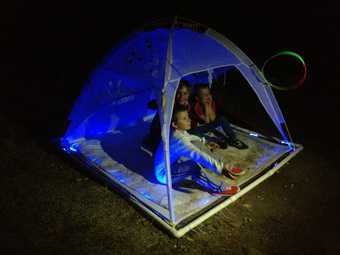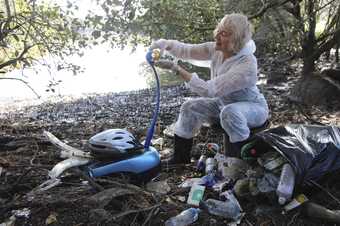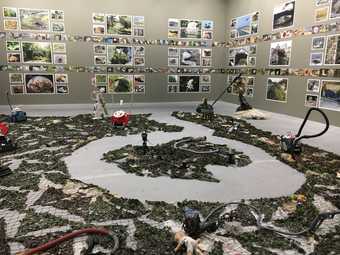What type of art does Bonita Ely make?
Artists make art for different reasons. One reason is to tell people about an issue they think is important. Australian Artist Bonita Ely is famous for making art about looking after the environment.
Ely is a multidisciplinary artist. This means she makes different types of art including painting, printmaking, photography, performance art and sculpture. She decides what her art will be about first, then how to make it.
How did she become an artist?
Ely first became interested in art when she was a little girl. She used charcoal to draw pictures of a hut in her back garden.
'When I was a tiny little kid before I went to school, I used to draw all over everything. My parents didn’t buy me pencils and paints, so I used charcoal.'
She was seven when she visited her first art gallery and thought she was in ‘magicland’. It inspired her to later study art at Sydney College of Art and St Martin’s School of Art in London.
What is her art about?
Ely uses her art to tell stories about nature. She is best known for making environmental art. This is art that talks about issues relating to the environment.
Some of her art shows what rivers, oceans or forests used to look like compared to how they look now. She describes herself as a ‘Giant Eye’, watching how humans treat nature and what this means for the future.

Bonita Ely, Sample grid, sandbar near Boundary bend, the Murray-Murrumbidgee Junction, 1977. Image courtesy the artist and Milani Gallery, Brisbane.
Ely feels very strongly about land rights. Land rights are the rights for indigenous peoples (the first people to be living in a place) to keep their home and not have it taken away from them by other people.
One artwork Ely is famous for is her ‘Murray River’ series. Growing up in Victoria, Australia, Ely lived near part of the Murray River. It is the longest river in Australia and a sacred waterway for many Aboriginal people, who are the indigenous peoples of Australia. Ely started photographing five different sections of the river in 1977 and over the years she used her photographs and made other artworks to show how the water became polluted.
In 1979 she created Jabiluka U02, a performance piece about a proposal to build a mine in Kakadu National Park in the Northern Territory of Australia. The work explores what would have happened if the proposal had been approved. It would have had a disastrous effect on the plants and animals. Ely was also angry that it would have a negative effect on the people who lived there. The area is home to an Aboriginal people called the Mirrar.

Bonita Ely, HQ: La Lune: Art Producing Energy, Long Reef Headland, Collaroy, 2014. Image courtesy the artist and Milani Gallery, Brisbane.
Her sculpture La Lune is a clever piece of environmental art because it creates energy. She used solar-powered paint on it. Not only does the paint glow in the dark, but it can also create energy by absorbing moisture in the air and turning it into solar power! Pretty cool eh? This shows how artists dont just talk about important issues with art, they can also help the environment.
Can you think of an artwork you'd like to make that would help the environment by producing energy, or reusing waste?
Is all Ely's art about the environment?
No! She also makes art about her personal experiences like being a mother. She also makes art about feminism and sometimes she combines both. While she was pregnant with her daughter she spent a lot of time taking photographs of dogs in Berlin. She thinks that why her daughter loves dogs so much.
These photographs also inspired a series of artworks she did called Dogwoman. One of them is called Dogwoman Makes History. It's about how some people think women should do certain things just because they are women.

Bonita Ely, Plastikus Progressus, 2017. Image courtesy the artist and Milani Gallery, Brisbane.
What materials does Ely use?
Depending on what she’s making, Bonita Ely uses different materials. She often re-uses plastic in her sculptures like broken toys, bottles and packaging.
One of her most famous pieces is an installation called Plastikus Progressus, which she made in 2017. It shows what life might be like in 2054.
She is imagining a future where humans have thrown away so much plastic that scientists have had to invent plastic-eating creatures that clean the oceans. As part of the exhibition, she also invented ‘snabbits’. These are animals that are half snail, half rabbit as a new type of food for humans to eat. They reappeared again in her work We Live to Be Surprised.
Have a look at home for three things that are made from plastic. What do you think they could have been made from instead?
Where does she get her inspiration from?
Although a lot of her work is about places in Australia, when she first started working as an artist she spent five years living abroad, learning about new things. When she lived in London in the 1960s she started creating environmental art. In the 1970s when she was living in New York she starting making feminist art.
She was also part of something called the fluxus movement. This was a made up of a group of artists who wanted to show that everyone can make art, not only famous people who have art inside galleries.
'How liberating the fluxus movement was. You could do anything. You could be out on the street, in a tree. It wasn’t about making art objects to put on a white box, and that suited me fine.'
If you were going to make a piece of art inspired by the fluxus movement, where would you like to exhibit your masterpiece, instead of inside an art gallery?

Bonita Ely, Plastikus Progressus, 2017. Installation view at documenta14, Athens, Athens School of Fine Arts Gallery. Image courtesy the artist and Milani Gallery, Brisbane.
Bonita Ely's artwork is on display at Tate Modern in A Year in Art: Australia 1992. Please visit the Tate website with an adult.
Tate, The Museum of Contemporary Art Australia (MCA) and Qantas partnered in an International Joint Acquisition Programme for contemporary Australian art. Bonita Ely, Jabiluka U02, 1979 Tate and the Museum of Contemporary Art Australia, with support from the Qantas Foundation 2015, purchased 2020.

